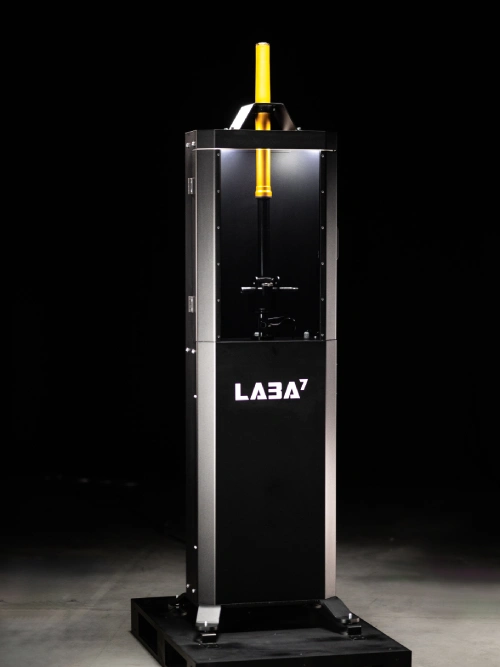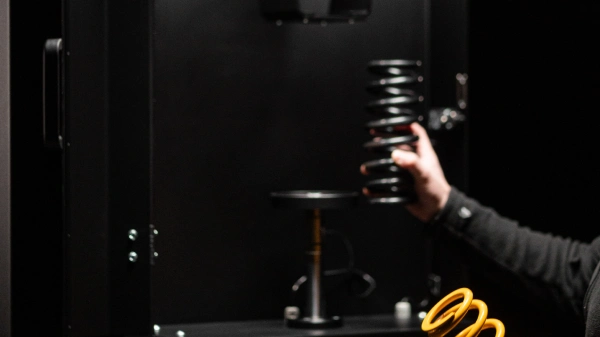Although springs are a basic component of any vehicle suspension system, they are among the most important ones.
Every damping system is designed to have a specific suspension travel to compress and extend with the compression stroke, which usually accounts for most of the suspension travel. The right spring will compensate for all the load the suspension system is under and will allow the damping system to work as intended.
So, before making any performance changes to the damping system, such as revalves or any other changes, it is crucial to check if the spring rates are the right ones for the case at hand.
Table of contents:
- Why spring rate is important?
- When to test the spring of a vehicle suspension?
- How to test coil springs?
- How to choose the spring rate tester?
- Spring rate tester adapters
- Signs that indicate your springs may need replacement
If you find suspension testing, tuning, and repairs interesting, join our social media community on Instagram, Facebook, or YouTube. We share tips and how-to’s on a weekly basis.
Why spring rate is important?
The spring rate, also known as the spring constant or stiffness, is an important factor for vehicles because it significantly impacts ride quality, handling characteristics, and load-carrying capability. Here are some key reasons why the spring rate is crucial:
- The spring rate determines how firmly or softly the suspension responds to bumps and road irregularities. Softer springs provide a more compliant ride by absorbing more of the impact, while stiffer springs transmit more of the road imperfections to the vehicle’s body, resulting in a harsher ride.
- Related to point 1, the spring rate affects the vehicle’s body motion and roll characteristics during cornering, acceleration, and braking maneuvers. Stiffer springs reduce body roll and improve handling precision by better controlling the vehicle’s weight transfer, while softer springs allow more body lean thus impairing handling but providing more comfort.
- Vehicles designed for hauling or towing need stiffer springs to prevent excessive sagging or bottoming out when carrying heavy loads. The spring rate must be matched to the expected weight capacity to maintain proper ride height and suspension geometry.
- Appropriate spring rates help maintain optimal tire contact with the road surface, maximizing traction and minimizing uneven tire wear caused by improper suspension geometry.
- The spring rate influences the amount of suspension travel and clearance between the tire and wheel well. Softer springs allow more suspension travel but may lead to bottoming out, while stiffer springs limit travel but improve clearance.
For professional drivers and riders carefully tuned spring rates are very important as they can result in podium places. But amateurs also must take into account what spring rate is fit for their weight and vehicle to avoid crashes and generally enjoy the driving or riding experience.

When to test the spring of a vehicle suspension?
Springs come in many shapes and sizes. Even identical-looking springs can have different qualities.
As suspension specialists, we recommend testing every new spring you install onto your vehicle. Testing the spring rate allows being 100% sure that it suits the vehicle, terrain, and your driving style.
There are also other times when testing the spring of a vehicle is recommended:
- Most manufacturers recommend inspecting suspension components like springs during routine maintenance intervals.
- Any significant impact, collision, or hitting of heavy road debris can potentially damage or weaken the springs. It’s wise to have them inspected after such events.
- If you notice a rougher ride, excessive bouncing, bottoming out, body lean/sway, or uneven tire wear patterns, it may indicate weakened or failed springs. Testing can diagnose the root cause.
- When buying a used vehicle, it’s prudent to have the suspension system thoroughly checked, including carefully inspecting the springs for wear or damage.
- During the spring/summer season, the temperature changes can affect spring performance. An inspection coming out of winter is a good practice.
How to test coil springs?
To test if the spring suits the rider, vehicle, terrain, and overall intended use, one must measure the spring rate.
The bad news is that it cannot be done without designated tools.
The good news is that getting this valuable data is a piece of cake with the LABA7 Spring Rate Tester.
Here is a brief tutorial on how to calculate the spring rate of suspension. You can also watch it on our YouTube channel.
- Start by opening the plexiglass door of the spring testing machine and remove the guiding bar. This bar is an important safety measure that helps prevent any damage to the machine and the operator in case of a catastrophic failure of a spring.
- Then open the software and insert the parameters.
- Insert the test name as you please.
- Input the travel that you want to test and also the maximum allowed force. The machine will always stop once one of these parameters is reached.
- Then you can choose between manual and automatic. If you choose the manual mode, the only thing that you have to keep in mind is that you have to use the side switch to set the preload of the spring. In case you choose the automatic mode shown, set the preload that you want to start with before doing the test and also the number of repetitions of the test.
- Lastly, leave a comment on whatever makes you remember this test. Once you press start, the machine will run the test according to the input.
- You don’t have to do anything else until it’s done.
Once the spring rate tester has completed all the tests, the results will be shown in two graphs.
You can select which repetitions or tests you want to show on the graphs and also select any points that you might highlight for the user and yourself. You can zoom in and zoom out on the graphs to see better and with more definition. On the side, you will have visible the spring rate from the chosen test and also the average spring rate from all selected tests.
You can also export the report with all the selected information and highlights. It will show the average spring rate, the test travel, the test name, and also the comments that you left.
Can’t get any easier than this and truth be told, there isn’t any other way to properly test springs. Not only it is a quick and straightforward process, but the spring rate tester allows you to share and keep a detailed log of the condition of the springs.
How to choose the spring rate tester?
Reliable spring break measurements require a constant and linear motion. That’s why LABA7 spring dynos are equipped with a mechanical linear motor that compresses springs vertically at a controlled speed as slow as 5mm per second.
Spring rate tester adapters
Spring rate tester is an effective way to improve your test results, as long as you have all the correct components for running these tests. LABA7 spring dynos are versatile mechanisms that support adapters for different vehicles, including mountain bikes and motorcycles.
Spring rate tester adapters for MTB
Mountain bikes are very popular and so is the need to properly service them. To help you become a more flexible mechanic, we have developed different spring rate tester adapters for MTB. With them, you will be able to assess various types of MTB springs and damping systems accurately and in no time.
For MTBs only, there’s a Mountain bike fork adapter, which is available for €350, with inserts for several types of forks, including 100×15, 110×15, 110×20 mm, or custom.
The other two versatile options are a Self-preload clevis and a U-clamp. The former allows for quick and effortless mounting and dismounting of rear shock absorbers, particularly useful when testing shocks with expansion tanks. A Self-preload clevis costs only €200, while a U-clamp – €100, and you can use both of them for motorcycle dampers too.
Spring rate tester adapters for MOTO
In the world of motorbikes, stability is one of the key aspects playing in the quality of your ride. However, an accurately adjusted spring rate impacts not only the vehicle’s balance but also its handling, ability to absorb bumps, and more. By using specialized LABA7 spring rate tester adapters for MTB, you can achieve these desirable results with minimal effort.
We offer three types of adapters, two of which are also suitable for automobile damping systems. The first is the Self-Preload Clevis, designed to quickly mount or dismount rear motorcycle and auto shock absorbers. The second is the Universal U-Clamp, which can be mounted on the top and bottom of the shaft. The price ranges from as low as €100 to €200.
For motorcycles individually, we have developed a MOTO fork adapter. Although it’s pricier than the adapters mentioned above, this single mechanism works with three different types of forks, including 54 mm, 55 mm, and 56 mm forks, ensuring your money pays off.
Signs that indicate your springs may need replacement
- Damaged or missing jounce bumpers (rubber cushions that prevent metal-to-metal contact when suspension bottoms out)
- Impact marks on the suspension stop point where jounce bumpers should make contact
- Uneven tire wear patterns, potentially caused by suspension issues
- Noticeable decline in handling performance or ride comfort
- Visible rust or corrosion on the spring coils
- Bent or kinked spring coils, altering the intended spring arc
- Excessive vehicle leaning, sagging, or body roll, especially when carrying heavy loads
While some of these issues could stem from other suspension components, they often suggest that the springs themselves are worn out and require replacement to restore proper suspension operation and vehicle control.

